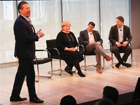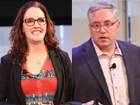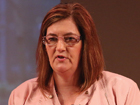
By Sara Bonizio, Contributing Editor
Wednesday, April 17, 2019 2:57 PM
Howard Purcell, OD, FAAO, president and CEO, New England College of Optometry, helped attendees extract valuable ideas from Weinswig and Sarasohn-Kahn’s presentations. Together with Ann Hoscheit, OD, FAAO, Dave Brown, president and CEO of IDOC and James Rosin, co-president of Rosin Eyecare, he explored the topics in the keynote presentations and discussed how attendees can take away actionable ideas and information from the Summit to help them compete in this new customer- and patient-centric environment. He also recognized the importance of current and future optometry students to be able to rely on the continued relevance and future existence of their chosen profession, as new technologies affect its evolution.

By Sara Bonizio, Contributing Editor and Mark Tosh, Senior Editor
Wednesday, April 17, 2019 2:52 PM
In the final Summit session, “Turning Data Wealth into Patient Health,” Amy Heymans (Cueva), founder and chief experience officer of Mad*Pow, spoke about the unique methods her company uses when working with health care clients, noting that “changing real-world behaviors” is central to addressing the key challenges facing both society and business. Mad*Pow’s methods draw upon design concepts and motivational psychology to help patients achieve greater health and wellness, financial wellbeing, education and sustainability.

By Sara Bonizio, Contributing Editor
Monday, April 16, 2018 12:29 AM
The optical industry is feeling the accelerating pace of change in our field. As we heard from Marge Axelrad in the opening remarks of the 2018 VM Summit, “competition can come from anywhere and everywhere—and it has.” A rapidly changing consumer mindset is bringing a new set of expectations to the vision care space, as explored by Erin Byrne and Jason Dorsey in the Leadership Challenge session.

By Sara Bonizio, Contributing Editor
Monday, April 16, 2018 12:28 AM
As he spoke about solving tough generational challenges for organizations and leaders, leading Millennial and Gen Z researcher Jason Dorsey peppered his session with penetrating insights illustrating distinct generational differences, such as Boomers and Gen X’ers clinging to pen and paper while Millennials Tweet, Snap and live video their experiences.

By Sara Bonizio
Monday, April 11, 2016 12:29 AM
It’s a news story that has picked up steam in the past couple of years, especially as daily hours of “screen time” have reached near-double digits: all this reading, emailing, Tweeting, Facebook stalking, shopping and surfing is behind significant increases in cases of dry eye, visual fatigue, headaches and even ancillary issues such as strained necks and cramped wrists (back in the day, when keyboards on handheld devices prevailed, one might recall the widely-reported “Crackberry Thumb” syndrome).

By Sara Bonizio
Monday, April 11, 2016 12:25 AM
A study published in the U.K.’s Eye journal in January, 2016 titled “Low-energy Light Bulbs, Computers, Tablets and the Blue Light Hazard,” concludes that blue light is not a health concern. The study’s lead author, John O’Hagan, head of the Laser and Optical Radiation Dosimetry Group of Public Health England in Chilton, U.K. asserted, “Even under extreme long-term viewing conditions, none of the low energy light bulbs, computers, tablets and mobile phones we assessed suggested cause for concern for public health.”